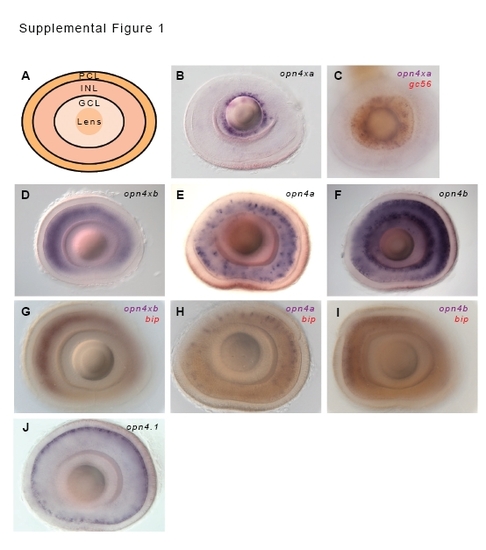- Title
-
Unexpected diversity and photoperiod dependence of the zebrafish melanopsin system
- Authors
- Matos-Cruz, V., Blasic, J., Nickle, B., Robinson, P.R., Hattar, S., and Halpern, M.E.
- Source
- Full text @ PLoS One
|
Diverse expression of zebrafish opn4-related genes in the developing retina. Profile of opn4-related gene expression in the larval retina from 3 to 5 dpf. Following whole-mount RNA in situ hybridization, larvae were embedded in LR gold media and 4 μm sections prepared. In A, the lens and retinal cell layers are indicated (GCL, ganglion cell layer, INL, inner nuclear layer, PCL, photoreceptor cell layer). (A–C) opn4xa is expressed in a small subset of cells in the ganglion cell layer. (D–F) opn4xb is transcribed in bipolar cells in a broad domain of the INL. (G–I) opn4a is expressed in clusters of bipolar cells scattered throughout the INL. (J–L) opn4b transcripts are found in three domains within the INL, where amacrine (arrowhead in L), bipolar (arrow in K) and horizontal cells (open arrowhead in K) are located. (M–O) opn4.1 expression is weakly detected at 3 dpf but, one day later, strong expression is observed in horizontal cells in the outer shell of the INL. Sparse opn4.1 expression is also found in the photoreceptor cell layer. EXPRESSION / LABELING:
|
|
Photoperiod length influences melanopsin expression. (A, C) Larvae housed in 14:10 LD or (B,D) 18:6 LD cycles were fixed at ZT1 at 96 hpf, and assayed for opn4-related gene expression. opn4a and opn4.1 expression in the inner nuclear layer is greatly reduced in the prolonged light conditions. Additionally, opn4.1 transcripts are only detected in the photoreceptor cells (arrowhead) of larvae raised in the 14:10 cycle. Over 90 larvae were assayed in 3 independent experiments. EXPRESSION / LABELING:
|
|
Rhythmic expression of opn4a and opn4.1. (A, B) Larvae maintained in 14:10 LD or 18:6 LD cycles were collected every 4 hours starting at ZT1. Expression of (A) opn4a and (B) opn4.1 show diurnal rhythms with different phases for each light cycle. The rhythm of opn4a expression is a single wide waveform in 14:10 LD, and either a dual waveform or an ultradian rhythm at 18:6 LD. Under the same LD conditions, expression of opn4.1 shows a reversal in the waveforms with respect to opn4a. (C) Summary graph representing the relative expression levels of opn4a and opn4.1 under the two photoperiods depicted as white (light phase) and black (dark phase) bars. |
|
Expression of zebrafish opn4-related genes in unique patterns in multiple retinal cell types. (A) Schematic diagram of the multilayered retina of the zebrafish larval eye with the photoreceptor cell layer (PCL), inner nuclear cell layer (INL), ganglion cell layer (GCL) and lens indicated. (B–J) Whole mount single or double RNA in situ hybridization at 5 dpf with the indicated probes. (B,C) opn4xa is expressed in a subset of cells in the GCL that coexpress gc56. (D–F) opn4xb, opn4a and opn4b are all expressed in subregions of the INL and some cells (G–I) coexpress bipolin (bip), a marker of bipolar cells. (J) opn4.1 is transcribed in horizontal cells in the outer lamina of the INL. |
|
Expression of opn4-related genes in extraocular tissues prior to retinogenesis. (A) opn4xa is weakly expressed in bilateral domains the dorsal diencephalon as early as 1 dpf. (B) At 2 dpf, the opn4xa-expressing cells (blue) are located in close proximity to the orthodenticle homolog 5 (otx5) expressing presumptive pineal gland (C) and medial to the dorsal habenular nuclei that express the Ca2+-dependent activator protein (cadps2) at 4 dpf [63]. (D–F) From 1–3 dpf, opn4a positive cells are found in the forebrain where (G) they coexpress the orthopedia (otp) gene, a marker of the preoptic area. (H) At 1dpf, opn4b expression is found in the ventral forebrain and (I) at 4dpf is expressed in the dorsal thalamus (J–K) opn4.1 is expressed in small subset of cells in the caudal hindbrain at 4dpf. opn4b is the only gene that is also expressed in the body, as shown in (L) a whole-mount embryo and in (M) a section through the tail region at 1dpf. |





